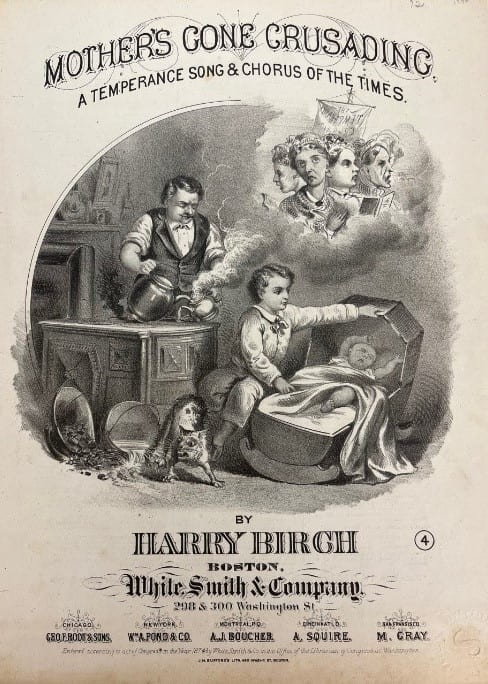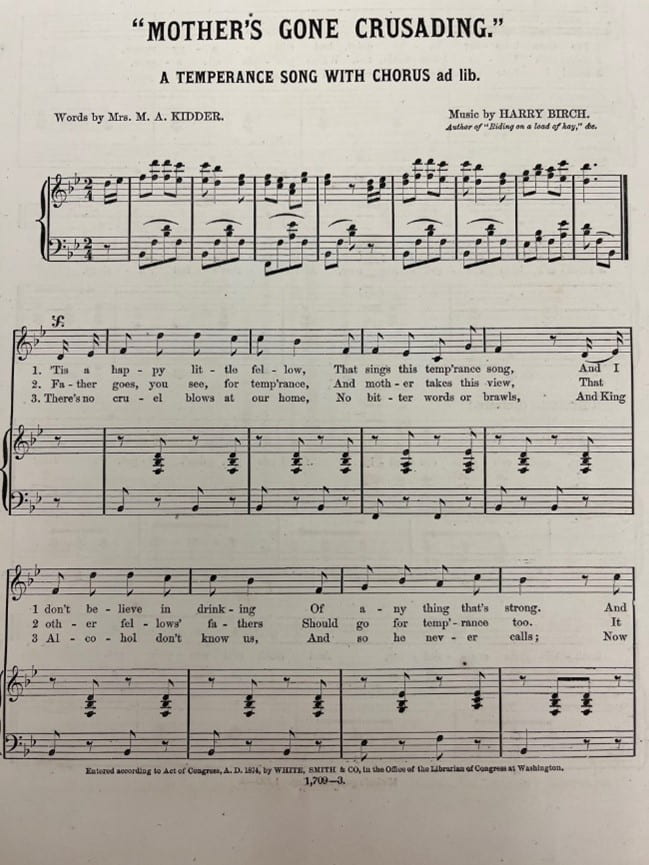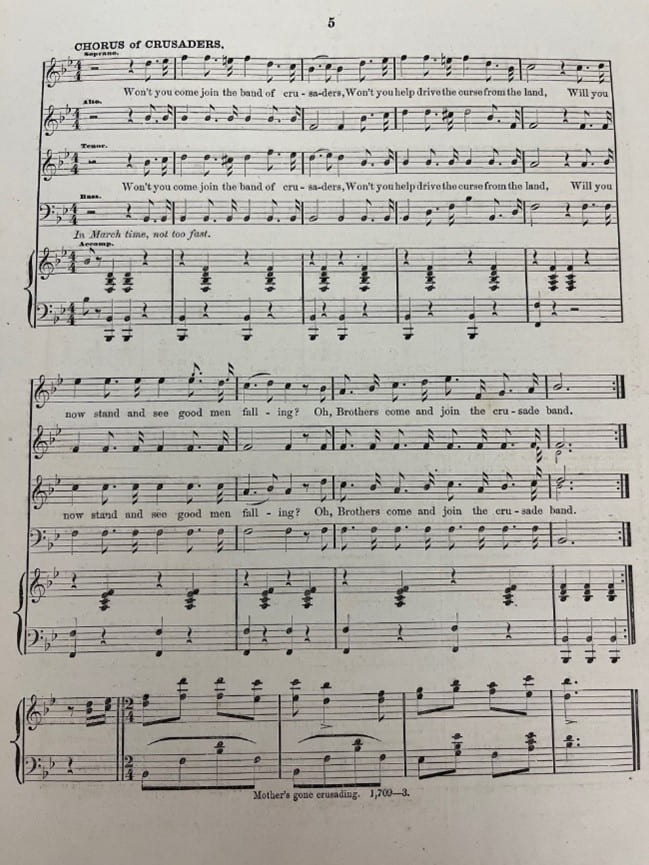What does music research look like? The next few posts will highlight music research by students in a Baylor School of Music class taught by Dr. Laurel Zeiss, a recipient of the 2022 Special Collections Teaching Fellowship. These students worked beyond traditional research and learned how to engage with primary sources in the Baylor Libraries’ Frances G. Spencer Collection of American Sheet Music. Enjoy exploring this unique collection through our new scholars’ works.
Mother’s Gone Crusading by Birch
by Julia Spanier
It is often interesting to see music and history walk closely hand in hand, for we can gain a lot of insights about the past in new ways. The title page pictured above is to a song titled “Mother’s Gone Crusading,” with lyrics written by M. A. Kidder and music by composer Harry Birch. This song, written in 1874 and published in the United States, shows the sentiments expressed during the temperance movement in America. It was written for SATB chorus with piano accompaniment, though the initial verses and refrain can be sung by a single voice. The illustration shows a boy rocking a baby in its cradle while the father pours a cup of tea, creating steam from which blossoms an image of women with a banner that appears to say, “The Temperance Crusade.” This drawing, while it is a direct illustration of the lyrics in the music, could function alone as its own political cartoon, which alone says that this is a piece of music meant to convince the listeners or musicians to agree with the message of temperance. In fact, the lyrics of the chorus section literally invite the listener to join “the band of crusaders” (Birch 5) and support their cause. According to the article “Temperance Songs” by Nancy Newman, many temperance songs included a section with many voices as a replacement for drinking songs (para. 3).
Before continuing with an analysis of the song itself, it is important to have background knowledge about the historical context of this piece. As afore mentioned, this song is a rather blatant display of opinions supporting temperance, which was a movement prolific between the early nineteenth century and early twentieth century. During this time, alcohol was often believed to be a danger to both the general quality of life in the household as well as the quality of labor in the workforce. While many are familiar with prohibition, which was a ban on alcohol ratified in 1919 and repealed in 1933 (Campbell para. 9), this piece of music was written in 1874 where the fight for a ban against strong liquors was still a work in progress.
Women were generally a huge part of this movement as their domestic life was often disrupted by their husbands’ alcoholic tendencies, though since they lacked the right to vote at that point in history, they instead found another way to express their opinions: the Women’s Crusade. According to Ohio State University’s Temperance and Prohibition site, the Women’s Crusade, lasting from 1873 to 1874, was “…a culmination across the United States of many years of women taking direct action against the saloon and the liquor traffic” (para. 1). Out of this group grew the more-organized Woman’s Christian Temperance Union (WCTU), founded in 1874, which operated with the same goal and had many chapters throughout the country (Campbell 4). While it is unclear whether the crusaders described in “Mother’s Gone Crusading” are referencing the Women’s Crusade or the WCTU, I believe the use of the word “crusade” in the lyrics and the title page illustration, along with the lack of reference to an organized group or union, hints to the Women’s Crusade.
The lyrics of the music, written notably by a woman, contain specific opinions that many who supported the temperance movement shared. It is evident that Kidder did not want to waste words on suggestive metaphors or ironic phrases. In the verses, she directly expresses the belief that rejecting alcohol makes a happy household and prevents severe arguments and domestic abuse. In the SATB chorus section, she openly calls alcohol “a curse” (Birch 5) and claims that it can turn a good man bad. With the song, we can see how the temperance movement permeated even popular music of the time.
Additional photos:
Works Cited
- Birch, Harry. “Mother’s Gone Crusading.” White Smith & Company, 1874.
- Campbell, Alice. “The Temperance Movement.” VCU Libraries Social Welfare History Project. https://socialwelfare.library.vcu.edu/religious/the-temperance-movement/. Accessed 25 October 2022.
- Newman, Nancy. “Temperance songs.” Grove Music Online. Oxford University Press. https://www.oxfordmusiconline.com/grovemusic/view/10.1093/gmo/9781561592630.001.0001/omo-9781561592630-e-1002263236. Accessed 14 November 2022.
- “Woman’s Crusade of 1873-1874.” Temperance & Prohibition. https://prohibition.osu.edu/womans-crusade-1873-74. Accessed 25 October 2022.



